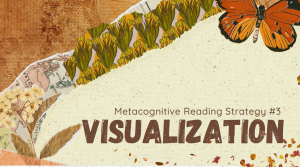19 Visualization
Learning Objectives
-
Practice using visualization to create a strong mental imprint of a narrative.
-
Use metacognitive reading strategies before, during and after reading fiction, non-fiction and graphics.
Chapter & Discussion
This chapter includes a presentation that can be navigated in a classroom setting or independently. You can access the presentation via the link below.
Work through the different sections of the chapter and discuss ideas and topics as they arise. If you’re working independently, take notes instead. Notes and active discussion will be helpful in navigating this week’s assignments.
What We Know
Making strong mental images when you read is a highly successful strategy. This will create an imprint of both the language data and the visual data in your mind (and it will link them). This makes you more equipped to understand and retain the information.
The ability to visualize links the text to a concrete experience – image, feeling, sound, small, or even taste. Making a mental picture is an important fix–up strategy that readers use when they experience difficulty understanding a text. Students can imagine what the scene or characters look like. They then describe to a peer what they see in their mind.
Emphasizing Sensory Details
- Try to use all five senses (sight, hearing, taste, smell, touch) while reading. Focus on specific sensory details mentioned in the story as you encounter them.
- Ask questions about sensory details as you read, such as “What do you think the character sees in this scene?” or “Can you imagine the sounds in this setting?”
- Engaging multiple senses in visualization can make the reading experience more immersive and relatable.
Example from Holes by Louis Sachar
Dinner was some kind of stewed meat and vegetables. The meat was brown and the vegetables had once been green. Everything tasted pretty much the same. He ate it all, and used his slice of white bread to mop up the juice. Stanley had never been one to leave food on his plate, no matter how it tasted.
As Stanley tried to turn over on his cot, he was afraid it was going to collapse under all his weight. He barely fit in it. When he finally managed to roll over on his stomach, the smell was so bad that he had to turn over again and try sleeping on his back. The cot smelled like sour milk.
Though it was night, the air was still very warm. Armpit was snoring two cots away.
Mindful Visualization
- Pause every so often during your reading, especially at descriptive or significant passages.
- Take time to close your eyes briefly and create mental images. Pay attention to the details, such as the colors, shapes, and emotions associated with the visualizations.
- Mindfulness is being aware of the moment. This is important for your reading experience so that you can be in the reading zone more often.
Example from Holes by Louis Sachar
The lizard is from six to ten inches long and has big red eyes. In truth, its eyes are yellow, and it is the skin around the eyes which is red, but everyone always speaks of its red eyes. It also has black teeth and a milky white tongue.
Looking at one, you would have thought that it should have been named a “red-eyed” lizard, or a “black-toothed” lizard, or perhaps a “white-tongued” lizard.
If you’ve ever been close enough to see the yellow spots, you are probably dead.
The yellow-spotted lizards like to live in holes, which offer shade from the sun and protection from predatory birds. Up to twenty lizards may live in one hole. They have strong, powerful legs, and can leap out of very deep holes to attack their prey. They eat small animals, insects, certain cactus thorns, and the shells of sunflower seeds.

Descriptive Language Analysis
- Use descriptive language, such as metaphors and vivid adjectives, to paint pictures with words.
- Identify instances of figurative language in the text and try to explain how these techniques contribute to visualization.
- Make a movie in your mind about the scenes as you read them. Try to direct the shots, the production design, and the casting.
Example from Holes by Louis Sachar
During the summer the daytime temperature hovers around ninety-five degrees in the shade—if you can find any shade. There’s not much shade in a big dry lake.
The only trees are two old oaks on the eastern edge of the “lake.” A hammock is stretched between the two trees, and a log cabin stands behind that.
The campers are forbidden to lie in the hammock. It belongs to the Warden. The Warden owns the shade.
Out on the lake, rattlesnakes and scorpions find shade under rocks and in the holes dug by the campers.
Here’s a good rule to remember about rattlesnakes and scorpions: If you don’t bother them, they won’t bother you.
Usually.

Sharing
- Talk about how you envisioned scenes with your peers. This can be done through group discussions or written reflections.
- Share your mental images and interpretations of the text. You can discuss similarities and differences in your visualizations and consider how various perspectives can enrich the reading experience.
- This strategy not only helps us refine our visualization skills but also promotes critical thinking and empathy by appreciating different viewpoints.
Example from Holes by Louis Sachar
Well, let me tell you something, Caveman. You are here on account of one person. If it wasn’t for that person, you wouldn’t be here digging holes in the hot sun. You know who that person is?”
“My no-good-dirty-rotten-pig-stealing-great-great-grandfather.”
The other boys howled with laughter.
Even Zero smiled.
It was the first time Stanley had ever seen Zero smile. He usually had such an angry expression on his face. Now he had such a huge smile it almost seemed too big for his face, like the smile on a jack-o’-lantern.
Assigned Reading
Here are this week’s readings. Additionally, please read for your own personal enjoyment for 1/2 hour each day. This will be called your “Reading Zone” reading and it will coincide with many upcoming activities.
Google Applied Digital Skills- Google Slides
Problem Set: Practice Your Skills!
Click here to complete a ten-question problem set on concepts in this chapter.
Completing problem sets like this can be an important element of independent study towards completing your HSE. I write these to resemble the style of questions you’ll find on the Reading and Language Arts GED.
Assignment: Photo Essay
Visualization is an important metacognitive reading skill that can help you more deeply connect with your book and comprehend the story. Take a moment to think about some of the imagery in your Reading Zone book so far.
Using Google Slides, create a photo essay of some of the most interesting or striking images from the story. Please follow these guidelines:
-
You should have eight slides
-
Each slide should include a photo of something that was in the book
-
You can use a Google image search to find the photos, then import them into your presentation (I can help with this step)
-
Finally, include a line of text on each slide that explains the photo you chose
Assignment: Reading Zone Response (250 Words)
For Reading Zone, you must find a novel that is interesting to you and enjoyable to read. If you need help finding a Reading Zone book, please ask. Please read your Reading Zone book for a half-hour each day. On class days, there will be time in class dedicated to reading.
Create a two-paragraph response to the reading you did this week. The first paragraph should summarize what you read this week. The second paragraph should address the following prompt:
What was a good scene in your book for visualizing? What senses did it activate? Imagine you are making a movie of that scene. What artistic choices would you make?
Attributions
Duke, N. K., & Pearson, P. D. (2002). Effective practices for developing reading comprehension. In A. E. Farstrup & S. J. Samuels (Eds.), What research has to say about reading instruction (3rd ed) (pp. 205-242). Newark, DE: International Reading Association. Reprinted in Journal of Education, 189, 107-122.
Mills, Kathy A. (2008) The Seven Habits of Highly Effective Readers. In Proceedings Stories, Places, Spaces: Literacy and Identity, National conference by the Australian Literacy Educators’ Association (ALEA) and Australian Association for the Teaching of English, Adelaide, SA.


